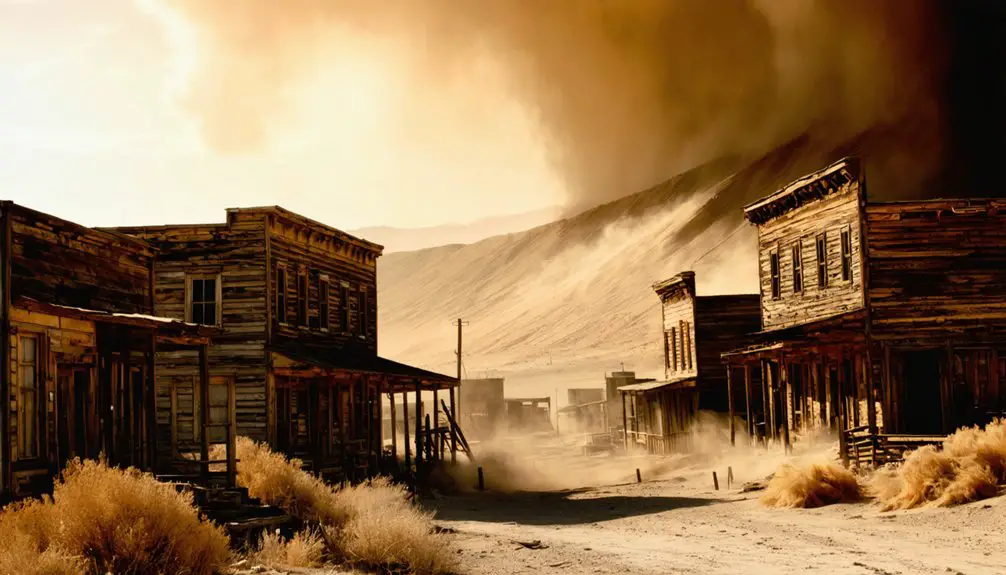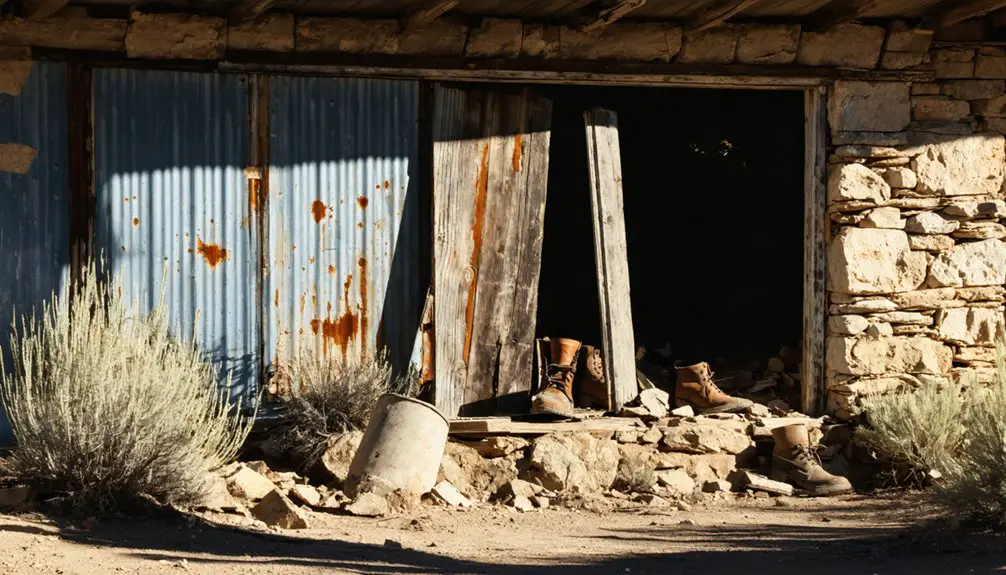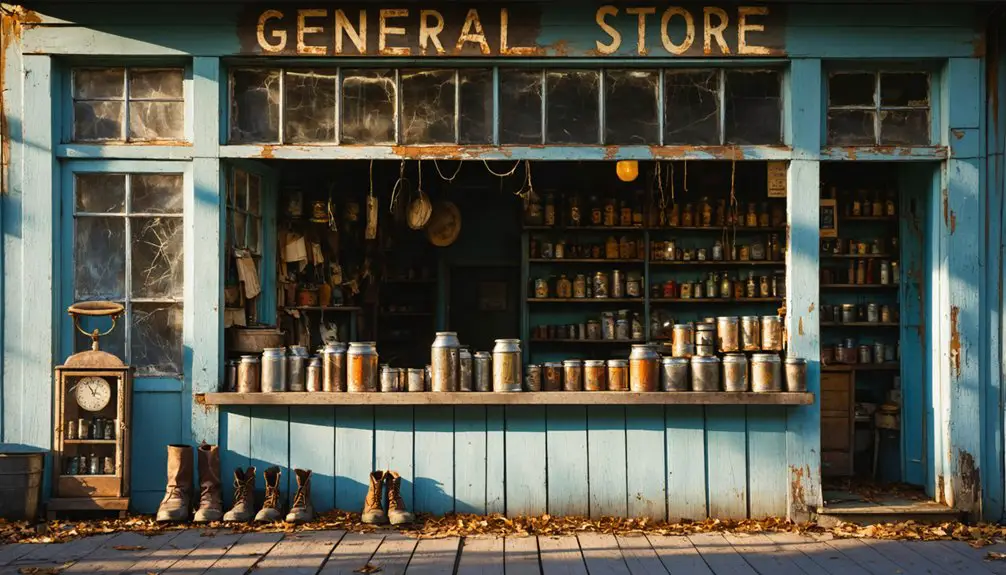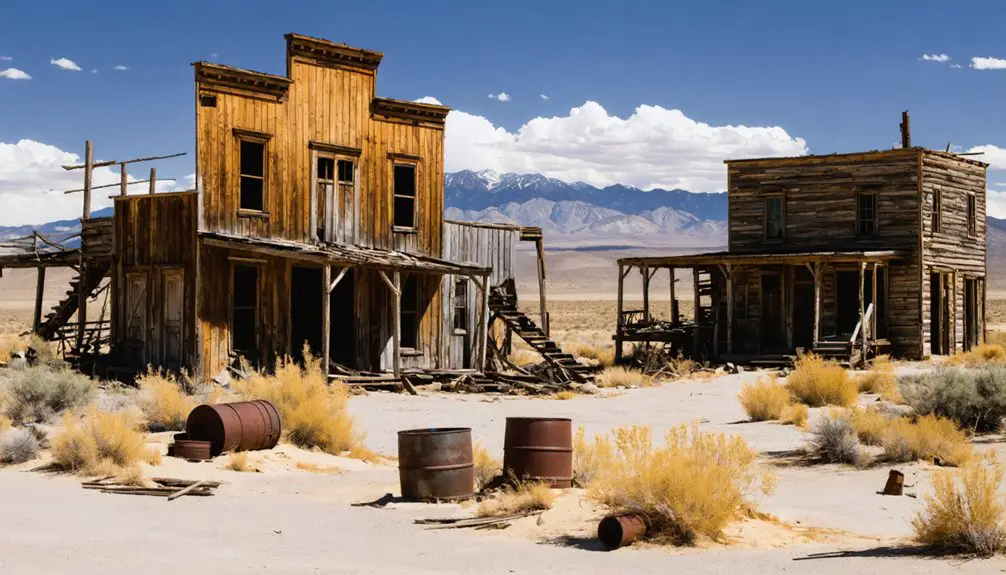You’ll find Silver Canyon (later renamed Aurum) among Nevada’s most historically significant ghost towns, where John Orr and Nicholas Kelly’s 1850 gold discovery transformed a quiet desert canyon into a thriving mining settlement. The town grew to 1,200 residents by 1861, featuring Nevada’s first stamp mill and a robust community life centered around mining operations. Today, you can explore the weathered ruins, mining remnants, and pioneer cemeteries that tell a deeper story of Nevada’s mining heritage.
Key Takeaways
- Originally named Silver Canyon, the town was renamed to Aurum in 1881 when establishing a post office.
- Gold was discovered in 1850 by John Orr and Nicholas Kelly, leading to the area’s first major mining boom.
- The town’s peak population reached 1,200 by 1861, becoming a significant freighting center for ore transportation.
- A tragic avalanche in 1884 killed three miners, highlighting the dangerous conditions faced by the mining community.
- Today, visitors can explore preserved ruins including the Pioneer Mill, mining tailings, and historic cabin remains.
The Discovery That Started It All
While the Spanish had mined silver in nearby regions during the 1700s, it wasn’t until June 1850 that John Orr and Nicholas Kelly’s discovery of gold in Gold Canyon near Silver City sparked the area’s first major mining boom.
Their gold discovery set off a chain reaction that would transform the region.
You’ll find that placer mining dominated the canyon for nearly a decade afterward, laying the groundwork for Nevada’s rich mining legacy.
The discovery site at Devil’s Gate quickly became a focal point for prospectors seeking their fortune.
Just like California’s Gold Rush history, these mining communities faced similar challenges as precious metals became scarce over time.
From Silver Canyon to Aurum: A Name’s Evolution
While you’ll find the town’s original name “Silver Canyon” reflected its geographic location, the arrival of a post office in 1881 prompted officials to seek a more distinctive identity.
The shift to “Aurum,” meaning gold in Latin, aligned perfectly with the area’s mining aspirations and growing gold operations. Interestingly, the chosen name represented chemical element Au on periodic 79, reflecting the scientific classification of gold. As the mining district expanded around Muncy Creek, Silver Canyon, and Siegel Creek, this new name helped establish the settlement’s formal identity and differentiate it from being just another mining camp. The post office continued serving the community until operations ceased in 1938.
Origins Behind Both Names
As mining activity flourished in White Pine County during the 1870s, the settlement initially bore the name “Silver Canyon” after its geographic location and abundant silver deposits. The name significance reflected both the natural formation and the district’s mineral wealth, establishing a clear identity for early prospectors and settlers.
When growth demanded formal organization in 1881, historical developments led to renaming the town “Aurum.”
You’ll find these key developments shaped the name change:
- Establishment of an official post office required distinct identification
- Latin word “Aurum” meaning gold represented broader mining potential
- Name distinguished the town from the geographical Silver Canyon feature
- New identity encompassed multiple subdistricts including Muncy Creek and Siegel Creek
Official Name Change Process
During the spring of 1881, Silver Canyon underwent a pivotal change when its name officially changed to Aurum, coinciding with the establishment of the town’s first post office on April 4th.
The name significance stemmed from the Latin word for “gold,” reflecting the community’s mining aspirations and identity.
Like the unchanged names of Carson City, Genoa, Gold Hill, Silver City, and Virginia City since 1860, this represented an important moment in Nevada’s place name history.
The postal authority played a key role in this alteration, as they’d need to approve and formalize the new designation.
You’ll find it wasn’t through legislative action but rather an administrative process typical of 19th-century mining settlements.
While residents continued using “Silver Canyon” as a geographical reference and even nicknamed parts of town like “Doughburg,” Aurum became the standardized name for official records, commerce, and mail delivery, helping distinguish the growing settlement from other mining camps in the region.
By 1881, the town had grown to include a store and saloon, establishing itself as a proper mining community.
Mining Growth Drives Change
Since its early discovery in the 1860s, Silver Canyon’s mining industry underwent dramatic transformations that ultimately influenced its name change to Aurum.
As mining innovations evolved and labor challenges emerged, you’ll find the area’s identity shifted from a purely silver-focused settlement to a diverse mineral producer. Major operations focused along a 900-meter strike length of the prominent Chihuahua vein system, marking the scale of industrial growth. The introduction of the MacArthur-Forrest process revolutionized mineral extraction methods in the region.
This transformation included:
- Chinese miners recovering $4 million in placer gold before 1900
- Bay State and Newark companies expanding silver operations into the early 1900s
- Discovery of tungsten deposits leading to wartime mining operations
- Implementation of advanced leaching tanks and cyanide processing at Donovan Mill
The name change to Aurum reflected this broader scope of mineral exploitation, as the region’s economy adapted beyond its silver mining roots to embrace gold, tungsten, and copper production.
Life in an 1880s Mining Community
In Silver Canyon’s heyday, you’d have found miners enduring grueling physical labor while facing constant dangers from unstable mine shafts, heavy machinery, and the ever-present risk of structural collapse.
Your daily work would’ve involved operating steam-powered stamp mills and coordinating with mule teams to transport precious ore, all while battling exhaustion and the threat of serious injury. Unlike typical mining camps of the era, Silver Canyon had a strong family-oriented atmosphere, with many women and children living alongside the miners. By 1871, workers operated eight major mills across the bustling mining town.
After your shift, you could’ve joined fellow miners at the local saloons and boarding houses, where entertainment and social connections helped ease the harsh realities of mining life.
Daily Pioneer Hardships
Life in Silver Canyon’s mining community tested even the hardiest pioneers through relentless physical demands and hazardous working conditions. The daily survival of these freedom-seeking pioneers meant confronting brutal realities at every turn.
Your pioneer struggles would have included:
- Working 12+ hour shifts in treacherous underground mines, where cave-ins, toxic gases, and equipment accidents posed constant threats.
- Living in hastily built shelters that offered little protection from harsh weather, with no reliable access to clean water or proper sanitation.
- Dealing with sporadic employment as mines opened and closed, forcing you to adapt quickly when operations shut down.
- Facing isolation in remote canyons while coping with limited medical care, creating a constant battle between self-reliance and basic survival needs.
Mining Town Social Scene
Despite the harsh realities of pioneer mining life, Silver Canyon’s vibrant social scene offered much-needed respite from daily hardships. You’d find social gatherings centered around the town’s saloons, where miners unwound with gambling, drinks, and occasional live performances.
The mainly male population formed transient relationships at boarding houses and hotels, while churches and fraternal organizations provided more structured community connections.
You could join community dances in multipurpose halls or participate in outdoor sports and hunting expeditions. The general store and post office served as informal meeting spots where you’d catch up on local news and share stories.
While ethnic diversity brought cultural richness to the community, social hierarchies emerged based on mining claims and business ownership. Telegraph communications and newspapers kept you connected to the outside world.
The Deadly Desert Avalanche

When three men perished in a devastating avalanche on February 11, 1884, Silver Canyon’s mining community faced an unexpected desert hazard.
Despite its arid location, the Schell Creek Range’s steep terrain created conditions ripe for deadly snow slides, challenging typical assumptions about avalanche awareness and mining safety in Nevada’s backcountry.
The tragic event claimed the lives of:
- Wallace McCrimmon
- John Fox
- W.H. Mitchell
Their graves now rest in Aurum’s cemetery.
You’ll find it remarkable that this bustling camp, complete with stores, saloons, and boarding houses by 1881, witnessed such a paradoxical natural disaster.
While desert mining towns often prepared for flash floods, this avalanche proved that mountain hazards could strike anywhere, regardless of climate.
The incident stands as a stark reminder of nature’s unpredictability in Nevada’s rugged terrain.
Mining Operations and Economic Impact
The discovery of precious metals in Silver Canyon during the late 1850s sparked a remarkable mining enterprise that would shape Nevada’s economic landscape.
You’ll find evidence of both placer and hard rock mining techniques that extracted silver, gold, and copper from the region’s rich deposits. By 1861, Silver City’s population had swelled to 1,200, transforming the area into a bustling hub of economic activity.
The district’s economic transformation was profound, with one of Nevada’s first stamp mills established in 1860.
You’ll discover how Silver City became a crucial freighting center, complete with stables and corrals that facilitated ore transportation. The mining boom created a ripple effect, spurring development of infrastructure, communication lines, and rail connections that integrated the entire region into Nevada’s growing economy.
Ghost Town Remains Today

Silent sentinels of Nevada’s mining era, Silver Canyon’s structural remains stand as weathered monuments to its once-thriving community.
Ghostly walls and foundations whisper tales of Nevada’s mining glory days, silent witnesses to Silver Canyon’s boom-and-bust legacy.
You’ll find scattered ruins preserved by the arid climate, where ghost town preservation efforts focus on maintaining “arrested decay” rather than full restoration.
When exploring Silver Canyon‘s remnants, you’ll discover:
- Wood and stone cabin ruins with partially intact walls
- Mining operation remnants including stamp mills and processing structures
- Historic artifacts like glass bottles, metal tools, and rail fragments
- Original mining tailings and slag heaps marking processing sites
Tourist interaction remains largely self-guided, with minimal facilities available.
You’re free to explore the weathered structures and discover authentic pieces of mining history, though you’ll need to prepare for rugged terrain.
The site’s preservation depends on responsible visitation as natural elements and occasional vandalism threaten these historic remains.
Connected Mining Towns and Regional History
Nestled within Nevada’s rich mining landscape, Silver Canyon formed part of an interconnected network of bustling towns that shaped the region’s development from 1870 to 1890.
You’ll find Silver Canyon’s story intertwined with nearby boomtowns like Silver Peak, established in 1864, and Silverado, which experienced its own rush in 1878. While mining techniques evolved from simple placer operations to more sophisticated quartz vein extraction, these towns’ fortunes rose and fell with each discovery and depletion.
The district’s economic fluctuations rippled through the region, with Chinese miners contributing notably by recovering nearly half the placer gold from Auburn and Barber Canyons.
The arrival of railroads and establishment of stamp mills, particularly in Silver Peak by 1865, further connected these frontier communities and enhanced their market access.
Daily Life and Essential Services

Despite harsh frontier conditions, daily life in Silver Canyon revolved around a dense network of crucial services that supported the mining community. You’d find daily routines centered around mining operations, with fundamental provisions available through general stores and markets along the town’s compact streets.
The backbone of Silver Canyon’s services included:
- Blacksmith shops maintaining critical mining equipment and transportation gear
- Processing mills strategically placed on hillsides for efficient ore handling
- Stagecoach and freight wagon services ensuring essential supply lines
- Saloons and restaurants providing meals and social gathering spaces
Living quarters were basic, with most miners occupying small cabins built from whatever materials were available.
You’d face challenging conditions, from limited food options to minimal medical care, yet the town’s services kept the mining operations – and your livelihood – running.
Notable Historical Sites and Landmarks
The remnants of Silver Canyon‘s industrial might stand as evidence to Nevada’s rich mining heritage.
You’ll find the Pioneer Mill, Nevada’s first silver mill, alongside seven other mills that once housed 95 stamps throughout the canyon. The historic architecture of the 30-stamp mill remains particularly well-preserved, offering a glimpse into early ore processing technology.
The area’s civic heritage is anchored by the 1876 Belmont courthouse, which served as the county seat for nearly three decades.
Standing since 1876, the stately Belmont courthouse anchored local government operations as the county seat until its closure.
You’ll discover the restored courthouse, complete with its original jail cells, now transformed into a museum. The surviving brick ruins of the Belmont bank and numerous boarding houses further illustrate Silver Canyon’s prosperous past, while local cemeteries provide poignant testimony to the community that once thrived here.
Frequently Asked Questions
What Was the Total Population of Silver Canyon During Its Peak?
You’ll find this ghost town’s exact peak population isn’t documented, but based on mining history patterns and similar Nevada towns, it likely reached between 1,000 to 2,000 residents during its heyday.
Are There Any Remaining Artifacts That Can Be Collected by Visitors?
Like precious time capsules frozen in place, you can’t legally collect artifacts at this site. Visitor guidelines and artifact preservation laws require leaving all historical items untouched for future generations to study.
What Happened to the Original Residents After the Town’s Decline?
You’ll find most residents scattered when mining profits fell, facing major economic impact. They relocated to nearby towns with better prospects or joined Nevada’s broader mining communities for work opportunities.
Is Silver Canyon Accessible by Regular Vehicles or Requires Off-Road Transportation?
Don’t let your sedan follow your dreams here – you’ll need an off-road chariot to conquer these wild trails. A high-clearance 4WD vehicle or ATV is essential for traversing Silver Canyon’s rugged terrain.
When Was the Last Active Mining Operation Conducted in Silver Canyon?
You’ll find the last active mining operations ended in the 1880s, though exact dates aren’t documented. Mining techniques were basic compared to modern standards, and today the site’s mainly valued for historical preservation.
References
- https://www.legendsofamerica.com/nv-silvercity/
- https://nevadamining.org/nevada-ghost-towns-nelson/
- https://nevadamagazine.com/issue/july-august-2019/10878/
- https://forgottennevada.org/sites/silverhill.html
- https://savingplaces.org/stories/explore-wild-west-mining-history-in-nevada-ghost-towns
- https://www.flyingdawnmarie.com/new-blog/silver-city-ghost-town
- https://nvtami.com/2024/01/17/lincoln-county-ghost-towns/
- https://en.wikipedia.org/wiki/Aurum
- https://usgenwebsites.org/NVWhitePine/towns/aurum.html
- https://kids.kiddle.co/Aurum



